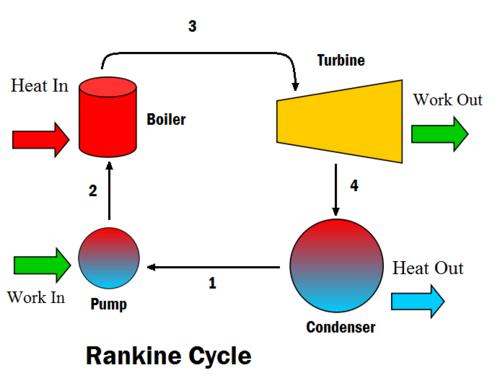Rankine cycle
The Rankine cycle or Rankine Vapor Cycle is the process widely used by power plants, such as coal-fired power plants or nuclear reactors, in which a fuel is used to produce heat within a boiler, converting water into steam which then expands through a turbine producing useful work.[1] This is a thermodynamic cycle which converts heat into mechanical energy, which is most often transformed into electricity by electrical generation. It was developed in 1859 by Scottish engineer William J.M. Rankine.[1]

The steps in the Rankine Cycle as shown in Figure 1 are:[1]
- Pump: Compression of the fluid to high pressure using a pump (this takes work)
- Boiler: Heating of the compressed fluid to the final temperature, including increasing the temperature to the boiling point, and the phase change from liquid to vapor
- Turbine: Expansion of the vapor in the turbine
- Condenser: Condensation of the vapor in the condenser (where the waste heat goes to the final heat sink (the atmosphere or a large body of water like a like or river)
The efficiency of the Rankine cycle is limited by the high heat of vaporization by the fluid. The fluid must be cycled through and reused constantly, therefore water is the most practical fluid for this cycle. This is not why many power plants are located near a body of water though, that's for the waste heat.
As the water condenses in the condenser, waste heat is given off in the form of water vapour, which can be seen billowing from a plant's cooling towers. This waste heat is necessary in any thermodynamic cycle. Because of this condensation step, the pressure at the turbine outlet is lowered and therefore the pump requires less work to compress the water, meaning higher overall efficiencies.

References
- ↑ 1.0 1.1 1.2 L. Albright, L. Angenent, F. Vanek. (May 6, 2015). "Stationary Combustion Systems" in Energy Systems Engineering, 2nd Edition. McGraw Hill. 2012. ch.6, pp.161-167
- ↑ Made internally be a member of the Energy Education team, adapted from Energy Systems Engineering by F. Vanek, L. Albright and L. Angenent
- ↑ USNRC. (June 1, 2015). The Boiling Water Reactor [Online]. Available: http://www.nrc.gov/reading-rm/basic-ref/students/animated-bwr.html

